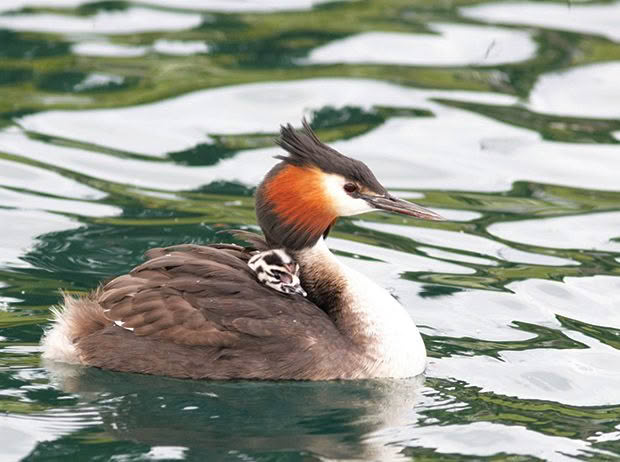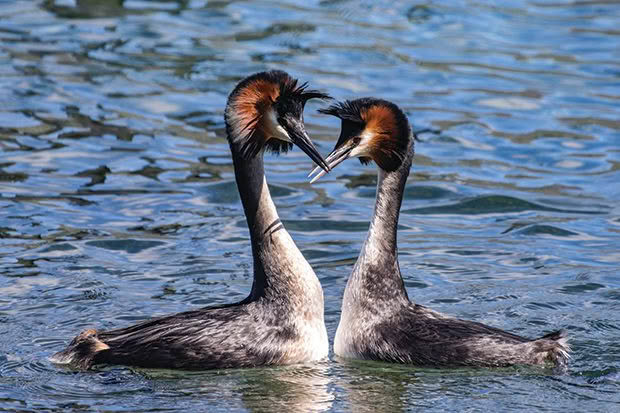The bird of the century’s Wānaka protectors

Photo: John Darby
In 2023, the pūteketeke went global. This Central Otago project has been its biggest cheerleader far longer.
Words: Bryony Ammonds-Smith
It’s not often a bird becomes an internet sensation. For a few weeks in late 2023, United States-based television host John Oliver led a viral marketing campaign for Forest & Bird’s competition, Bird of the Century. His feathered friend of choice? The great crested grebe, otherwise known as the pūteketeke. Suddenly, all eyes were on the dramatically plumed, short-legged, nationally vulnerable bird many had never heard of. It won in a landslide.
It was a surprisingly busy few weeks for the Lake Wānaka Grebes Project. The scheme has existed for a decade, long before John Oliver dressed up in an elaborate costume to promote the pūteketeke to the world. In that time, Lake Wānaka has gone from a scarce habitat to a haven for dozens of grebes. John Darby is the man to thank.
According to Wānaka conservationist Petrina Duncan, the story goes that “John had spotted a pair of grebes on Lake Wānaka that were unsuccessfully able to attach their nests to anything stable. Not many lakes offer the right habitat, and Lake Wānaka’s level changes so much that the nests are susceptible to destruction.”
John, also a dedicated conservationist, awarded an Officer of the New Zealand Order of Merit in 2023 for services to wildlife conservation and science, knew he had to do something. As grebes cannot walk on land, they have no choice but to create their nests on water. He built a box that could be anchored to the bottom of the lake, big enough for them to build on.
The grebes were so fond of the platforms they returned every breeding season, and John had to build more.

Key members of The Lake Wānaka Grebes Project: (left to right) John Darby, Petrina Duncan and Markus Hermanns.
Petrina became a grebe “ambassador” in September 2023 when the project’s popularity blossomed. She works as official spokesperson, spreading the word and sometimes donning a feathered costume to draw people in.
John, now 87, is only just starting to slow down. “He still goes down to see the grebes every single day during the breeding months and makes meticulous notes,” Petrina says. “Until this summer, he was kayaking around all the nest platforms and checking on the birds.”
Every year, more platforms are put on the lake. “The most boxes we put out this year were 21, and every single one was occupied.”
Petrina reckons the team has exhausted the lake’s capacity for nests. It’s not the worst problem, especially as nearby lakes have also set up platform projects, but it has meant that the grebes are now fighting for space.
“There were more grebes than there were nests. It was mayhem.”
The project’s primary concern isn’t the bird’s newfound global stardom. Petrina and the team must also secure funding to continue educating the public and rescuing any platforms that wash up on the lake’s edge.
The Bird of the Century has its protectors, but John and Petrina hope that one day it will be able to nest without human help.
FAST FACTS ABOUT THE PŪTEKETEKE

Photo: Oscar Thomas
• Their legs are set far back on their body, meaning they can’t walk on land.
• Grebes have courtship rituals that involve dancing, diving and fanning their feathers.
• Nesting occurs between September and March. According to Petrina, their yearly residency at Lake Wānaka brings excited tourists to the lake.
• The website New Zealand Birds Online suggests that the combined population of grebes in Australia and New Zealand are less than 3000. In Aotearoa, they are labelled as nationally vulnerable.
facebook.com/wanakagrebes
 This article first appeared in NZ Life & Leisure Magazine.
This article first appeared in NZ Life & Leisure Magazine.
